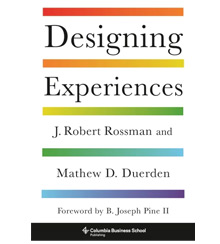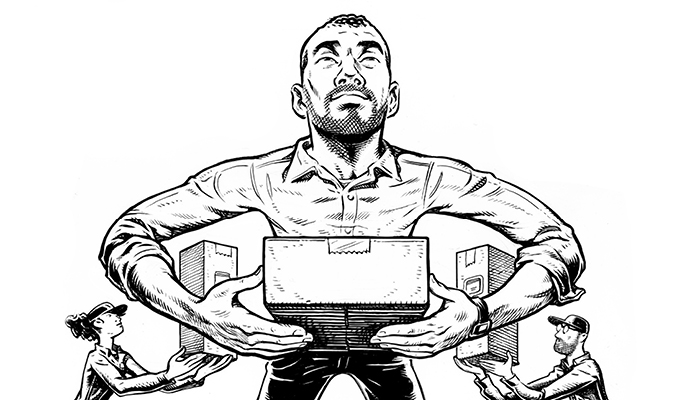How to build a great experience
A new book by two professors provides a tool kit for designers of customer, user, and employee experiences.
Designing Experiences
by J. Robert Rossman and Mathew D. Duerden, Columbia Business School Publishing, 2019
In 2017, the Marriott School of Business at Brigham Young University announced that henceforth the Department of Recreational Management would be known as the Department of Experience Design and Management. The idea that immersive and engaging experiences produce value and deliver competitive advantage has come a long way in the 20 years since Joe Pine and Jim Gilmore welcomed us to something they called the “experience economy.”
Designing Experiences is the latest in a long line of books that have appeared on the subject. In it, J. Robert Rossman, a professor at Illinois State University, and Mathew Duerden, an associate professor in the aforementioned department at the Marriott School, touch on many of its predecessors (including one in which I had a hand, Be Our Guest) in a concise textbook that serves as both a theoretical foundation and a how-to guide for experience design.
The theoretical foundation, which appears mostly in the first two chapters, bogs down a bit in explaining what constitutes an experience. This murk stems from Pine and Gilmore’s positioning of experiences as an economic activity unique from products and services. Rossman and Duerden carry this forward by arguing that experiences differ from products and services because the person on the receiving end of an experience must be actively co-creating it. “Experience demands conscious attention, engagement, and action — in a word, participation,” they write.
The idea that immersive and engaging experiences produce value and deliver competitive advantage has come a long way in the 20 years since Joe Pine and Jim Gilmore welcomed us to the ‘experience economy.’
This distinction isn’t clear to me. Is there any product or service we can buy and consume that doesn’t require our participation in some form or other? And even if it were possible not to participate in the acquisition and use of certain products or services (say, buying groceries or cutting the lawn), mightn’t that count as a very good experience for some of us?
The core content and big payoff in the book is the how-to guide. It begins with an ascending framework of five types of experiences: prosaic, mindful, memorable, meaningful, and transformational. The authors say that prosaic experiences, such as brushing your teeth, don’t demand conscious attention — that our minds are on autopilot (inaccurately likening that state to behavioral economist Daniel Kahneman’s System 1 thinking). Then they write, “As an experience designer, you need to recognize the importance of intentionally designing prosaic experiences.”
This theoretical sticking point aside, the distinctions between the five kinds of experiences are very useful. They are the building blocks (microexperiences, such as test-driving a car or checking into a resort) that make up end-to-end experience journeys (macroexperiences, such as buying a car or vacationing at a resort). “You can critically analyze the sequence, flow, and frequency of different experience types to better orchestrate the macroexperience,” write the authors.
Knowing the attributes of the five experiences also opens the door to elevating them. Witness Starbucks, which turned the prosaic experience of ordering a cup of coffee into the mindful, even memorable, experience of ordering a venti skinny vanilla latte.
With the experience types in hand, Rossman and Duerden provide designers with a tool kit for their craft, including the experiencescape, design thinking, experience mapping, and touch point templates. Experiencescapes are the compositional elements of an experience: the people involved, the setting and objects, the rules and relationships that govern it, and the choreographing of the action within it. The principles of design thinking, which the authors borrow from IDEO, guide the composition process.
Experience mapping is the means of linking microexperiences in an intentional and heterogeneous way. Intentional, because, as the folks at Disney’s theme parks like to say, “Everything speaks” — down to the changing texture of the pavement as you walk from Frontierland to Adventureland in the Walt Disney World’s Magic Kingdom. Heterogeneous because variation in experience journey keeps the participant engaged.
Touch point templates define microexperiences. “Think of the experience map as a roadmap to your desired destination, and your touchpoint templates as detailed directions about how to get there,” write the authors.
The above tools speak to the craft of experience design. But designing is also an art form. To address this dichotomy, the authors suggest that designers develop their storytelling prowess by studying Gustav Freytag, who, in 1863, defined a five-phase dramatic structure for stories, and Joseph Campbell, who argued that many myths are essentially the same story: the hero’s journey. Rossman and Duerden also define two sets of factors that produce compelling experiences: technical factors, such as courtesy, that fulfill baseline service expectations; and artistic factors, such as customization, that enhance and embellish experiences.
It may be a bit of stretch to claim, as Rossman and Duerden do in the final chapter of Designing Experiences, “that companies that deliver great experiences thrive and those that don’t die.” I’m a long-term customer of two cable companies and various insurers that all deliver horrendous customer experiences and yet, they are very much alive and highly profitable. But I’d sure be glad if their leaders read this book and put its tool kit to work.
Author profile:
- Theodore Kinni is a contributing editor of strategy+business. He also blogs at Reading, Writing re: Management and is @TedKinni on Twitter.






